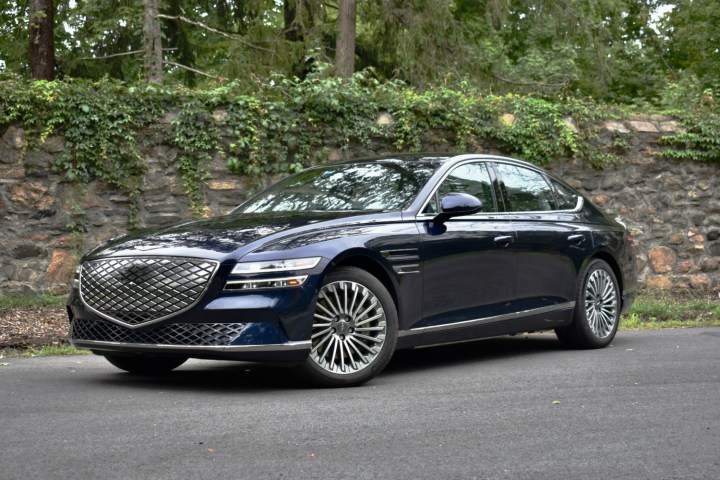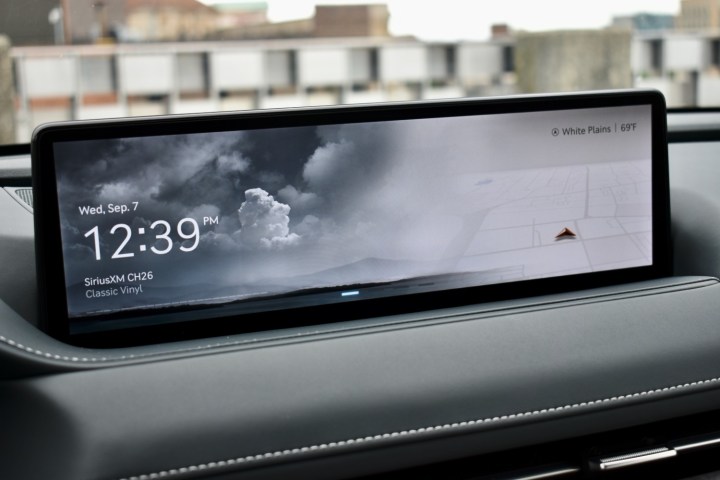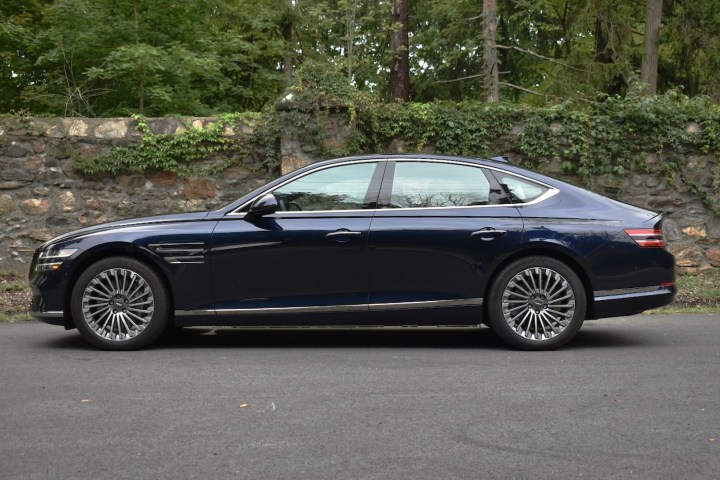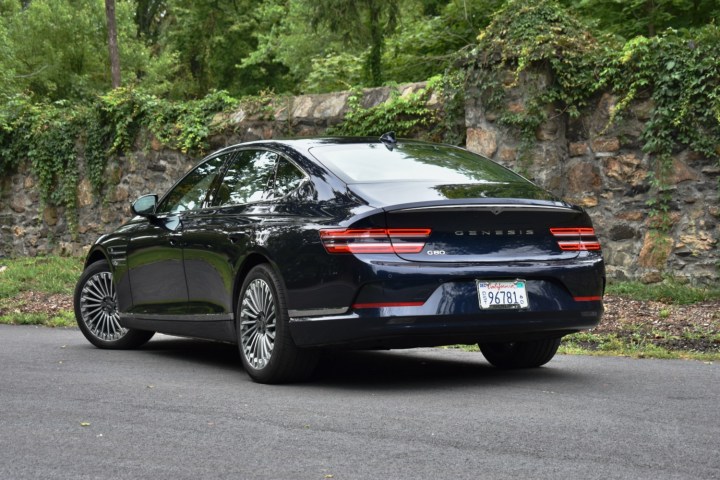
“The Electrified Genesis G80 wraps EV efficiency in classic luxury.”
- Old money style
- Excellent chassis
- High-power charging
- Surprisingly efficient
- Awkward touchscreen
- Unimpressive driver-assist tech
Luxury automakers are quickly embracing electric cars, but Genesis is making the shift at whiplash pace. Hyundai’s luxury brand has only existed since 2015, but it’s now rolling out two EVs that represent very different approaches to electrification. The GV60 is a small crossover SUV designed from the ground up as an EV, while the 2023 Genesis Electrified G80 is based on an existing gasoline car.
It’s the latter that we’re concerned with here. While “electrified” is often used in the auto industry to denote hybrids, the Electrified G80 is an all-electric version of the Genesis G80 luxury sedan with no tailpipe to speak of, It replaces the standard G80’s four-cylinder and six-cylinder engines with a pair of electric motors.
New for 2023, the Electrified G80 starts at $80,920 with destination. With so few electric sedans on the market, the Genesis occupies a space between the cheaper Tesla Model 3 and BMW i4 and the more expensive Tesla Model S, Lucid Air, and Mercedes-Benz EQS, with more focus on luxury and comfort than the sporty Audi e-tron GT and Porsche Taycan. And unlike most other EVs, the Electrified G80 gets nearly every feature as standard equipment. The only option on our test car was $575 Capri Blue paint, bringing the as-tested price to $81,495.
Design and interior
The Electrified G80 is the automotive equivalent of strutting about wearing a top hat and monocle. While not wholly anachronistic, it doubles down on old-money styling cues, such as the chrome fender vents and leering disco ball grille. Combine that with Genesis’ signature quad LED headlight and taillight strips, plus a sleek fastback roofline, and you get a very distinctive design — distinctive from other brands, at least. Aside from the shiny grille and lack of exhaust tips, the Electrified G80 is virtually indistinguishable from the gasoline G80.
The luxury aesthetic continues on the inside. The Electrified G80 has standard Nappa leather upholstery, with heating and ventilation for the front seats. Rear-seat passengers get a fold-down armrest with cupholders. Genesis is also bolder with color and material choices than other luxury brands. Our test car’s white upholstery was paired with blue trim instead of the usual black or gray, along with matte wood trim. Granted, the latter looked a bit like the countertops at a Long Island diner.
The G80 is the automotive equivalent of strutting about wearing a top hat and monocle.
The Electrified G80 felt pretty spacious, but on paper it gives up some room compared to its gasoline sibling. It has less headroom in both rows, and while front-seat legroom is about the same as the gasoline version, the EV has significantly less rear-seat legroom. The BMW i4 comes fairly close to the Genesis on passenger space, although its seats are nowhere near as comfortable.
At 10.8 cubic feet, cargo space is also about three cubic feet less than the gasoline G80. While there is a small passthrough between the rear seats, they don’t fold down completely. The trunk floor also has a hump, so the space that’s available is not completely flat. The BMW i4 once again offers a comparable amount of space, but it’s also a hatchback, which makes loading and unloading items a bit easier. Neither car has the “frunk” popularized by Tesla.
Tech, infotainment, and driver assist
The standard infotainment system includes a 14.5-inch touchscreen, 12.3-inch digital instrument cluster, a head-up display, and four USB ports (two front, two rear). A 21-speaker Lexicon audio system and wireless device charging are standard as well. Apple CarPlay and Android Auto are also standard, but wireless versions aren’t available.
We liked the digital instrument cluster, which has a 3D effect like a 1990s baseball card that makes the virtual speedometer needle appear to stand out from the background. But the touchscreen was awkward to use because of its positioning. It’s set far back on the dashboard behind a hump that you have to reach over. Genesis’ voice control is also less sophisticated than that of German luxury brands like BMW and Mercedes. You do get a rotary controller with its own small trackpad, at least.
Like other Genesis models (and those of parent Hyundai), the Electrified G80 also gets Digital Key, which turns a smartphone into the key fob. Instead of carrying a separate fob, drivers can use a compatible phone (this feature is Android-only for now) to unlock or lock the car, start it up, and drive.
The touchscreen was awkward to use because of its positioning.
Another carryover feature from other Genesis and Hyundai models is Remote Smart Parking Assist. While other automakers offer parking-assist systems that can steer a car into spaces, you don’t have to be in the car to use this one. And the Electrified G80 gets the now-familiar Hyundai/Genesis/Kia Blind-Spot View Monitor camera system, which shows a camera view in the instrument cluster. While no longer novel, it’s still very helpful when merging or overtaking.
Blind-Spot View Monitor is also standard, along with a host of other driver aids including forward-collision warning, rear cross-traffic alert, a driver-attention monitor, adaptive cruise control, lane keep assist, safe exit assist, and a rear occupant alert feature that reminds you to check the back seats before leaving the car.
Also standard is Highway Driving Assist, which levels up the adaptive cruise control by adding automated lane centering. Tech like this is already common in cars of all price ranges, and Genesis’ version doesn’t exactly distinguish itself. While we appreciated the straightforward controls and the ability to automatically match posted speed limits, acceleration was frustratingly slow, and steering movements awkward. Instead of following curves, the system always seemed like it was trying to cut them, only pulling the car back in line when it approached the limits of a lane. And you’ll definitely get your hand-strength exercises in while gripping the steering wheel, which is the only way the car knows you’re still paying attention.
Driving experience
The all-wheel drive Electrified G80 has one electric motor powering each axle, fed by an 87.2-kilowatt-hour battery pack. Combined output from the two motors is 365 horsepower and 516 pound-feet of torque. The electric model can’t match the 375 hp of the most powerful gasoline G80, but outdoes that model’s 391 lb.-ft. of torque. That extra torque was definitely noticeable when accelerating away from stoplights; it was easy to chirp the tires despite the Electrified G80’s all-wheel drive.
The Electrified G80 has the character of a classic luxury car, combining speed and comfort while keeping the drama to a minimum. Standard adaptive dampers provide the pillowy ride expected in the luxury category, along with excellent body control that means passengers won’t be disturbed by jarring sideways motion in corners. Genesis’ choice of 19-inch wheels likely helps as well. The wheels are large enough to appear properly scaled with the rest of the car, but still leave room for thick tire sidewalls, which provide an additional cushioning effect.
The Electrified G80 has the character of a classic luxury car.
While not a performance car per se, the Electrified G80 was also surprisingly game for twisty roads. The same suspension elements that coddle the driver and passengers with a smooth ride helped the G80 glide through corners with the agility of a smaller car. The steering was nicely weighted — especially in Sport mode, which also quickens accelerator response — and the rear end provided just the right amount rotation to help expedite cornering. Like a real performance car, the G80 communicated the sensation of the road, but in a more subtle way that preserved the luxury atmosphere.
The Electrified G80 is a great car to drive, but it also works well as an EV. It has strong enough regenerative braking to enable one-pedal driving, and can even (gradually) slow to a stop without any application of the brake pedal. And while converting a gasoline car to electric power can often uncover unpleasant sounds normally masked by the engine, the Electrified G80’s cabin was as quiet as an abandoned shopping mall.
Range, charging, and safety
Official range and efficiency ratings haven’t been published yet, but Genesis estimates a respectable 282 miles of range. A standard heat pump and battery heater should help maintain maximum range even in cold weather. We also saw average energy use of between 3.7 kilowatt and 3.9 kW per mile during a week of driving — greater efficiency than we expected.
One of the most impressive aspects of the Electrified G80 is its 800-volt electrical architecture, which enables DC fast charging at up to 350 kW, and can charge the battery pack from 10% to 80% capacity in 22 minutes, according to Genesis. That’s some of the quickest charging currently available, although actually finding a 350-kW fast-charging station can still be challenging. Genesis is also including three years of free 30-minute charging sessions at Electrify America locations.
Connect to a 240-volt Level 2 AC charging station — the kind normally installed as home chargers — and the Electrified G80 can charge at up to 10.9 kW, taking the battery pack to 10% to 100% in seven hours and 22 minutes, Genesis claims. The Electrified G80 also has vehicle-to-load (V2L) capability that can discharge power at 3.6 kW to run devices or appliances.
The Insurance Institute for Highway Safety (IIHS) and National Highway Traffic Safety Administration (NHTSA) haven’t published crash-test ratings for the Electrified G80, although both organizations did give the gasoline G80 high marks. While that’s encouraging, those ratings may not translate to the Electrified version as the addition of the battery pack and subtraction of the engine may change the way it performs in a crash.
The Electrified G80 does get the same warranty coverage as other Genesis models, including a five year, 60,000-mile new-vehicle warranty and a 10-year, 100,000-mile powertrain warranty. Genesis also provides a separate 10-year, 100,000-mile warranty for the battery pack and other EV components.
How DT would configure this car
There isn’t much configuration to be done, as the Electrified G80 is only sold in one all-inclusive trim level encompassing everything from Nappa leather and premium audio to a dual-motor all-wheel drive powertrain and a full suite of driver aids. That doesn’t make the Electrified G80 a great value, though, as this is simply the level of feature content one should expect in a roughly $80,000 car.
The price point does position the Genesis well against other EVs, undercutting the Audi e-tron GT, Lucid Air, Mercedes EQS sedan, Tesla Model S, and Porsche Taycan. With its 800-volt electrical architecture, respectable estimated range, and one-pedal driving capability, the Electrified G80 is also a good EV that nicely replicates the experience of traditional luxury cars.
It may be harder to find an Electrified G80 than other EVs, however, as it’s only available in eight states: Arizona, California, Connecticut, Nevada, New Jersey, New York, Utah, and Washington. Its base price and the fact that it’s assembled in Ulsan, South Korea, also disqualifies the Electrified G80 from eligibility for the federal EV tax credit under the latest rules.
More competition is also on the way. The Lucid Air Pure is scheduled to arrive in the fourth quarter of 2022 with an $87,400 base price (before destination), but 406 miles of range. The Mercedes EQE sedan should also reach dealerships soon at a significant discount from the EQS. So while the Electrified G80 is an impressive first effort, when it comes to EVs, change is constant.
Editors' Recommendations
- Mercedes G580 electrifies an off-road icon
- Mercedes-Maybach EQS SUV is old-school luxury — electrified







